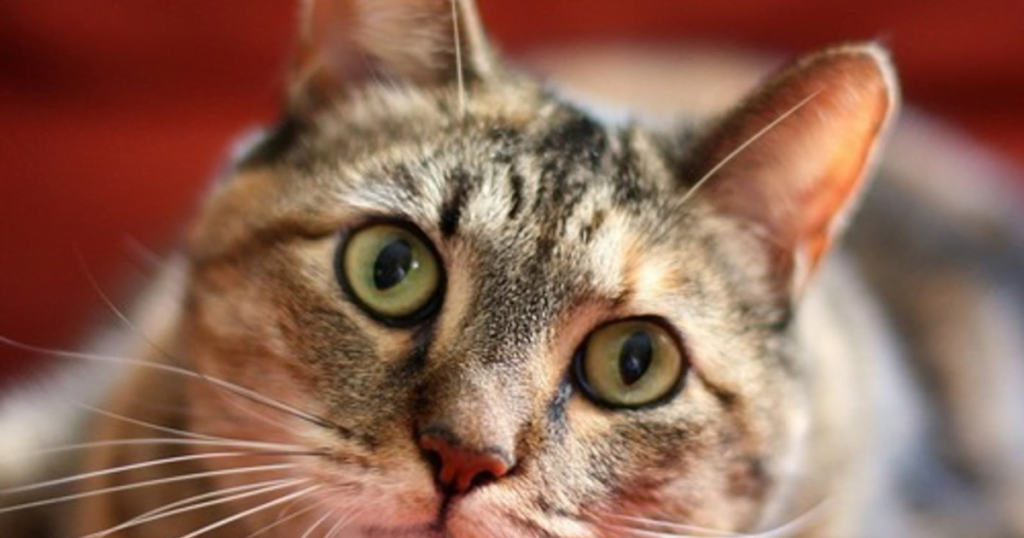Body language of a cat in pain
The body language of a cat in pain is sometimes not easy to read.
Cats are mysterious creatures, very independent and so much different from a dog but when you know what to look for you can tell when your cat is in pain.
Here are some signs to watch out for.

Is your Cat in Pain?
Cats in pain can have gradual or sudden changes in posture :
Eyes
The pupils of the cat are constricted, eyes wide or partially open, or squinted.
The eyebrows can be drawn together.
Tail
The tail is, the same as with a dog, tucked between legs, under the body, held straight out, or rapidly wagged from side to side.
Vocalizations
Cats in pain often have a change in vocalization. They may cry out when touched or move suddenly. They might also make a low moan or continuous cry. Changes in appetite are common as well–a decrease in eating and drinking is often seen in animals in pain.
Behavioural changes
Cats in pain often have a decrease in activity level. They may be reluctant to move or move only with great difficulty. When they do move, they may pace or walk stiffly. Cats in pain may also hide more than usual.
Muzzle
Stretched to the sides and different from normal, the whiskers of a cat in pain point outwards. The mouth may be open or partially open, with the tongue often hanging out. Breathing may be laboured and heavy.
Ears
The ears of a cat in pain are often held back or to the side. They also can be stretched, folded, and turned outward.
If one ear moves while the other ear stays still, inner or middle ear disease could be the reason.
Body posture
Cats in pain often adopt a “hunched” posture: low to the ground with the legs drawn up under them. The head may be held down and turned to one side.
Other indications of a cat’s posture are sitting in a stooped, protected position, with tight muscles. Crouching with the stomach pressed to the ground.
Head
Cats in pain rub their head on the ground or against solid objects.
Stretching or leaning against objects
The stretching or leaning against objects relieves the tension in the cat and can be an indicator of pain.
Breathing Rate
The change in breathing such as wheezing, tachypnea, and hyperventilation. These changes in breathing rate must be treated as an emergency.
Swelling
Swelling in any area of the body should not be ignored. It could be a tumour or a wound that has turned into an abscess.
Other Visible Signs of the Body Language of a Cat in Pain
Discharge from the eyes or nose: A sign of an upper respiratory infection.
Debris or fluid in the ear indicates an ear infection or a parasite like ear mites.
Very frequent ear flicking, several times a minute or hour, is a symptom of ear infection, such as mites, lice, fleas, or growths. Cats twitch their ears to try to ease the discomfort.
Hiding
Cats are very good at hiding their pain and often do not show any of the common signs until they are in a great deal of discomfort.
Early diagnosis and treatment are essential for the best possible outcome.
As you can see, there are many changes in both appearance and behaviour when a cat is in pain. If you think your cat is in pain, it is important to take them to the vet as soon as possible for an examination.
Behavioural Signs that the Cat is in Pain
Turning away when you pet them: if a normally friendly cat flinches and turns away something is wrong. The general behaviour of the cat changes. Noticing sudden changes in behaviour or disposition is key to knowing your cat is in pain.
Changes in eating pattern: some cats in pain will stop eating or won’t eat as much as usual. It may be because they are in pain and do not want to get up to go to their food bowl. A sore mouth or toothache can also be another reason your cat avoids eating.
Refuge: when a cat is in agony, he or she will seek refuge under the bed, couch, or even the closet. They may be restless and not able to settle down.
Reduced movement and activity: many cats with pain will be less active and sleep more.
Hostility: when your cat is in pain, it may show hostility when approached or stroked. It may scratch and deliberately avoid humans by hiding.
Sounds: making frequent unpleasant sounds such as mournful whining, hissing, and growling.
Scratching and digging: scratching at objects or digging at surfaces is the cat’s way to relieve tension and pain.
Cancer
Cancer is a serious illness that can strike cats of any age, breed, or gender.
While early diagnosis is key to successful treatment, many owners are unaware of the subtle body language cues that their cat may be displaying.
Cancer in cats often manifests as a change in behaviour, so it’s important to be aware of your cat’s normal habits.
If your cat suddenly becomes more withdrawn or stops using the litter box, this could be a sign that something is wrong.
Cancer can also cause weight loss, lethargy, and appetite changes.
Paying close attention to your cat’s appearance and behaviour is the best way to catch cancer early.
Conclusion Body Language of a Cat in Pain
There are many ways for you to see if your cat is in pain. It might not be always easy but when you love your cat you will know and can find a solution to help your cat.
Important is to bring the cat to the vet if you are not sure.
FAQ Body Language of a Cat in Pain
u003cstrongu003eWhat are some of the common signs and symptoms that a cat is in pain?u003c/strongu003e
Some of the common signs and symptoms include body posture changes, such as sitting in a hunched or protected position, breathing rate changes, swelling or redness in any area of the body, discharging from the eyes or nose, debris or fluid in the ears, frequent ear flicking, reduced movement and activity levels, hostility towards others or avoidance behaviours, sounds like whining and growling, scratching and digging.
u003cstrongu003eWhat are some possible causes of pain in cats?u003c/strongu003e
There are many possible causes of pain in cats, including injury or trauma to the body; diseases affecting internal organs such as the kidneys and liver; infections; u003ca href=u0022https://ourcontinentalcat.com/arthritis-in-cats/u0022u003earthritisu003c/au003e; and cancer.
u003cstrongu003eWhat should I do if I think my cat is in pain?u003c/strongu003e
If you think your cat is in pain, it is important to take them to the vet as soon as possible for an examination. Early diagnosis and treatment are essential for the best possible outcome.





